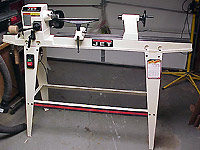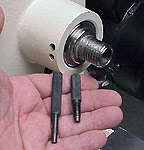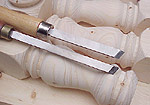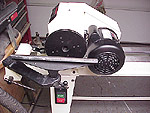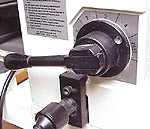This is a Veteran Owned site
![]()
JET JWL-1236 Wood LatheExpanding CapabilitiesText and photos by Tom Hintz Wood turning has fascinated me for a long time. Until now, my only experience with wood lathes was watching His Normness (The New Yankee Workshop) when his projects included turnings. I like how turned parts accent many projects and felt the time was right to bring those capabilities to my wood shop. The decision on which lathe to buy was easier than I anticipated. I read all the turning-related online forum threads I could find, listened to advice from current wood turning hobbyists and researched the available models in my price range extensively. Past experience with my JET contractor-style table saw certainly skewed the decision somewhat. The JET JWL-1236 lathe seemed to be the best value for the money I had to spend. Buying tools in the past made me aware that more than the lathe itself would be needed to fully realize its potential, and to prevent stutter-steps in the learning process. As I researched lathes, I found that adding a basic set of quality chisels and a chuck would greatly enhance its capabilities. The down side is that these additions, and a few other related smaller purchases, added about 40-per cent to the price of the lathe itself. I could have done this on less money, but would almost certainly have spent more in the near future.
Another consideration was that, like many woodworkers, the time available for running back and forth to my local (25 miles one way) woodworking store is very limited. Making this purchase as complete as I could in one trip also made fiscal sense. Getting the Lathe HomeCapacity between the centers is an attractive feature in a lathe. Large capacity is nice in the shop, but can make getting a lathe home a chore if a small truck or van is not available. The box my JET JWL-1236 came in was 56 ¾-inches long, 13-inches tall and 15-inches wide. Since the folks who designed my Toyota Camry probably did not consider cargo of this size, improvisation was necessary. With the heavy headstock end (motor end) of the box inside the trunk and turned diagonally, it still stuck out of the vehicle several inches. With rope lashing the box to the car, and the trunk lid to the box, my new lathe handled the ride home without damage to the box or its contents. SetupAssembling the JET JWL-1236 is very easy. The stand goes together in minutes with nuts and bolts, hand tightened only at this point. Bolt the lathe to the stand, plug the motor into the pre-wired, pre-installed switch and then tighten all the nuts and bolts. All of the parts fit very well, and the proper number of everything was in the parts bags.
There is one catch. The instruction manual warns that assembly is a two-person job, and this should be taken to heart. The JET JWL-1236 bed and headstock are pre-assembled, making this is a very heavy unit that is also awkward to handle because the major portion of the weight is concentrated on the headstock end. In addition, to join the two assemblies it is necessary to align holes in lathe bed with those in the still-wobbly stand. With two people, this task is much easier, and safer for you and the JET JWL-1236. Install the bed extension, tool rest assembly, a couple of handles and the lathe is essentially complete. With assembly complete, you should have an Allen wrench, drift rod, back plate, outboard turning support and two mysterious pins left over. They are unexplained in the instructions, but important. The only adjustment I had to make during assembly was to loosen the large adjuster nut (about ¼-turn) under the tool rest body. This was necessary to get the body onto the lathe bed rails. I slid the tailstock down to the headstock and carefully brought the points of the centers close to each other to see how closely they were aligned. They were dead on. Before turning the JET JWL-1236 on, I went over all the nuts and bolts one more time. I also checked all the handles that secure the headstock,
tool rest body, and tailstock in place. The last thing I wanted was for something to move unexpectedly. Cleaning Metal PartsThe instruction manual recommends using kerosene to clean the thick, greasy protective coating from the bare cast iron parts. While kerosene certainly cleans well, so do many non-flammable cleaners. Many woodworking shops are in, or attached to occupied dwellings, making the use of flammable materials more risky than other readily available options. I used plain Windex to clear the bulk of the grease, followed by WD-40 to finish the cleaning process and protect the metal at the same time. A few paper towels and very little elbow grease produced clean, shiny, protected bed rails. I also extended the tailstock ram fully and gave it the same Windex/WD-40 cleaning. The centers in the head and tailstock were removed and cleaned with a WD-40 laden rag. Both of the centers have Morse tapers that should be cleaned regularly to help prevent jams and damage. Included Tools
The JET JWL-1236 I purchased was one of JET's Gold series and came with an eight-piece chisel set. As is the case with many "free" tools, they are not the best, but with a little honing, do work well enough to get you started. I purchased a beginners set of Crown HSS (High Speed Steel) turning tools and found them to be easier to use, which seemed to help the learning process considerably. Machine CapabilitiesAll wood lathes have similar capabilities. The major difference among the various models is how big a piece can be worked on and how fast it can be turned. The only other major concerns are how the machine is constructed and price. The JET JWL-1236 impressed me on all counts. One thing you will not find on the JET JWL-1236, or in the instruction manual, is a speed chart that quantifies the six available settings. See the chart elsewhere in this article for the actual speeds for each setting, obtained from JET's Tool Doctor. The headstock pivots 90-degrees so the spindle points towards the operator for turning larger face plate items. A spring loaded indexing pin makes sure the spindle is oriented properly, and locking handle keeps it there. JET includes a sturdy tool rest mount that should accommodate virtually any reasonably sized turnings. This tool rest mount attaches to that bed extension you were wondering about when installing it.
The tailstock on the JET JWL-1236 has a removable center that provides a 3/8-inch-diameter hole through which a drilling bar can be run for boring the center of things like lamps. The capacity between centers and from the spindle to the bed will always be points of compromise. Woodworkers always would like more, but price and available space throttle these desires. SafetyThe JET JWL-1236 comes with a full-face shield to help protect your face and eyes from flying chips of wood. Wearing safety glasses along with the hood is a good idea. Lathes, like any power tool with spinning parts, have the ability to reel the operator in should clothing, long hair or a body part become entangled in the spinning wood or lathe parts. Pay attention to what you are doing and work safely. As with any power tool, read and understand the instructions that come with the tool before operating it. The manufacturer benefits from the safe operation of their products and will provide safe operation guidelines and warnings about any special considerations that particular tool presents. Operating InstructionsIf you are inexperienced with operating a lathe, I strongly suggest obtaining a book that at least covers the basics. While the JET instruction manual provides an overview of basic lathe operations, it is not a complete instructional course. Getting the most from a wood lathe, and doing it safely, requires a sound understanding of techniques and procedures. There are many books, videos and classes that will make learning to operate a lathe much easier and safer. Overall ImpressionsThe JET JWL-1236 re-enforces my belief that JET makes quality tools at a good price. The fit and finish are excellent and operation is smooth and surprisingly quiet. The JET JWL-1236 may not be the heaviest lathe available, but the approximately 183-pounds appears to be more than adequate. I have yet to notice shaking or vibration not directly related to a seriously out-of-balance work piece. Truing the work up at low speed returns the lathe to silky-smooth operation. If additional ballast is desired, the heavy-duty stand has stretchers on which a platform could be installed to hold sand bags or whatever (within reason) you want to use. So far, though I have turned a few 5-inch-diameter pieces of an oak tree - bark and all - I have not encountered a situation that made me think additional weight was necessary. The controls are simple and easy to operate. The locking levers that keep the head and tailstocks steady are easy to use and effective. Spring loaded, handles are used on secondary controls so they can be positioned out of your way. I have lots to learn about woodturning but am confident having the JET JWL-1236 will help. The last thing I need is a cheap machine complicating the learning process. I have had very good luck with JET equipment and look forward to many years of enjoyment and productivity from my JET JWL-1236.
A regular poster on one of the woodworking forums suggested that when buying my JET JWL-1236 I also pick up tarps and protective coatings for my other woodworking equipment that would now remain dormant. To be sure, there has been a flurry of time spent at the lathe, but I look forward to when the novelty subsides and the lathe becomes a useful, and hopefully equal, asset in my woodworking shop. Do you have a comment about this page? - Email Me! |
All written, photographic and drawn materials are property of and copyright by NewWoodworker.com LLC 2000-2019. Materials may not be used in any way without the written permission of the owner.

